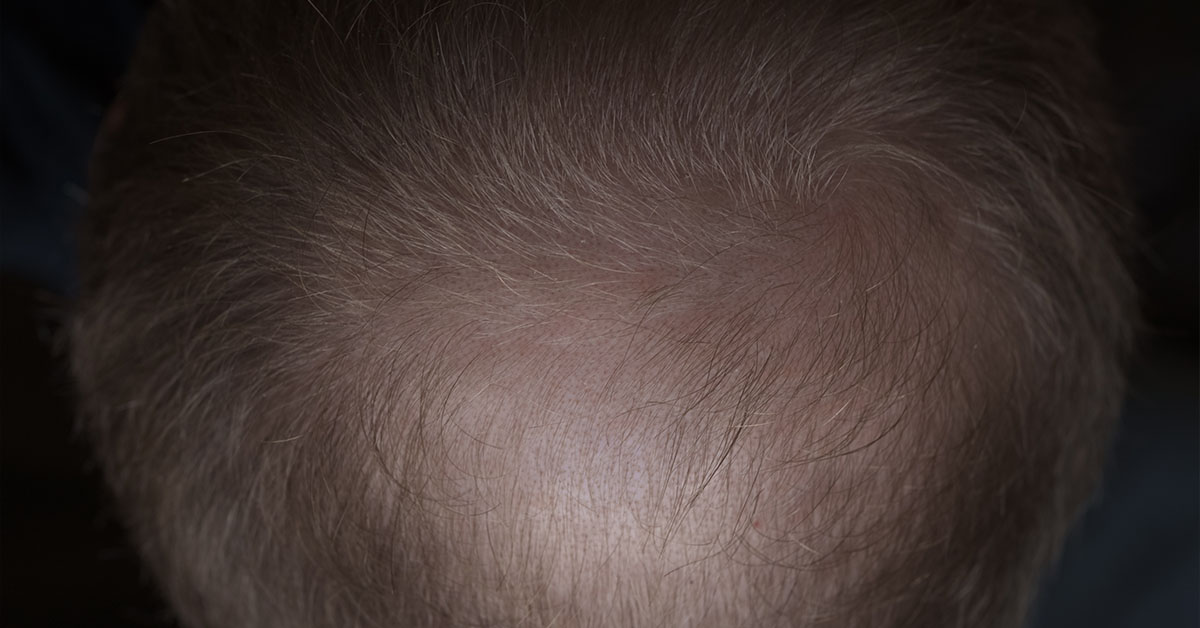By far, androgenic alopecia is the number one reason our clients undergo hair replacement procedures. Nationwide more than 80 percent of hair transplants are performed to reverse the effects of this type of hair loss.
Androgenic alopecia is also referred to as male pattern baldness (MPB) or female pattern hair loss. It is caused by a group of genetic factors linked to heightened sensitivity to dihydrotestosterone (DHT) – a testosterone byproduct. DHT causes hair follicles to constrict, which produces thin hairs that fall out more easily. This condition progresses as one ages and one’s hormone levels fluctuate.
What Does Androgenic Alopecia Look Like?
In those who are assigned male at birth (AMAB), androgenic alopecia is characterized by a receding hairline that develops in a distinctive M-shaped pattern. This may be accompanied by hair loss at the vertex of the scalp, which eventually leaves a horseshoe-shaped ring of hair around the sides and back of the head.
Androgenic alopecia may progress further, ultimately causing complete baldness. This process occurs in seven different stages that can be tracked on the Hamilton-Norwood scale.
Androgenic alopecia in those assigned females at birth (AFAB) is quite different. It occurs as diffuse thinning across the entire scalp. The first signs of female pattern baldness are a widening part and a sparser, less-defined hairline.
What Age Does Hair Loss Start?
Signs of androgenic alopecia in men may begin to appear as early as one’s late teens. By age 20, nearly 20 percent of men experience some visible hair loss. By age 30, that number is approximately 25 percent. The likelihood of hair loss in one’s 30s and 40s increases dramatically, with nearly half of men reporting obvious hair loss by age 50. By age 60, two-thirds of men are either bald or have significant hair loss.
Onset for women typically begins much later. Most women do not have noticeable hair loss until they are in their 40s… but the percentage of women experiencing hair loss grows quickly. By age 50, around 40% of women have noticeably thinner hair.
Is Hair Loss from Your Mother or Father?
A common belief is that androgenic alopecia is passed down from the mother’s side of the family and that female pattern baldness comes from the father’s side. Those popular myths contain only a kernel of truth.
While the dominant gene that controls hair loss may come from the opposite-sex parent, androgenic alopecia is caused by multiple genes passed down from both sides of one’s family. At least 12 genomic regions are implicated in hair loss. So, it’s almost a certainty that some of those genes come from one’s mother and some from one’s father.
Can You Reverse Hereditary Hair Loss?
Androgenic alopecia is irreversible. Certain hair loss treatments may be able to stave it off for a few years or to slow down the rate of hair loss… but once the hair is gone, it will not grow back. The best, most effective androgenic alopecia treatment is hair replacement surgery. The good news is that today’s procedures are safe, permanent, natural-looking, and more accessible than ever.
Reef Hair Can Help You Achieve the Hairline You Desire
Reef Hair offers a full spectrum of treatments and transplantation options for androgenic alopecia in all genders. We provide device-assisted ARTAS® and NeoGraft® procedures, as well as classic manual FUE and FUT transplants.
Contact us today to set up a consultation. We will perform a full hair & scalp analysis and discuss potential treatments so you can choose the one that will help you achieve the hairline you desire!


